Abstract
1. Human short-wave S cone signals are important for colour vision and here we examine whether the S cone signals also contribute to motion and luminance. 2. Detection was measured with moving patterns that selectively stimulated S cones-violet sine-wave gratings of 1 cycle deg-1 on an intense yellowish field. For rates up to 12 Hz, detection was governed by non-directional mechanisms, possibly of a chromatic nature, as shown by three findings: moving gratings had to be suprathreshold for their direction to be identified; the threshold ratio of counterphase flickering versus moving gratings was low; and direction-selective adaptation was essentially absent. 3. Evidence for less sensitive, directional mechanisms includes the following: at high velocity, the direction of movement of the violet gratings can be identified just slightly above the detection threshold; directional adaptation was strong with a suprathreshold test pattern; velocity was seen veridically for clearly suprathreshold patterns; and a counterphase flickering test, added in spatial-temporal quadrature phase to a similar suprathreshold mask, had identical detection and direction-identification thresholds. 4. Interactions of long-wave L cone and S cone signals in direction-selective mechanisms were measured with an orange counterphase grating and a violet counterphase test, both flickering at the same rate and presented in spatial quadrature phase on the yellowish adapting field. Direction identification thresholds, measured as a function of the temporal phase of two gratings, demonstrated both that the S cone signal lags considerably behind the L cone signal (an effect that strongly varies with S cone light adaptation), and more strikingly, the S cone signal summates with a negative sign and thus is effectively inverted in direction-selective mechanisms. 5. Quantitatively similar temporal phase functions were obtained with uniform violet and orange flicker when a luminance discrimination criterion was used: thus the S cone signal summates negatively with the L cone signal for both discrimination of luminance flicker and the direction of motion. 6. The temporal phase functions accurately predicted threshold summation for identifying the direction of motion of a pair of violet and orange gratings moving with the same velocity but with different spatial phase offsets. Once the relative temporal phase lag of the S cones was compensated for, there was linear threshold summation for the violet and orange patterns when presented in effective (physiological) spatial antiphase, and clear cancellation when presented in phase. This and related experiments show a linear summation of S, M and L cone signals for direction detection, with the S cones having a negative sign.(ABSTRACT TRUNCATED AT 400 WORDS)
Full text
PDF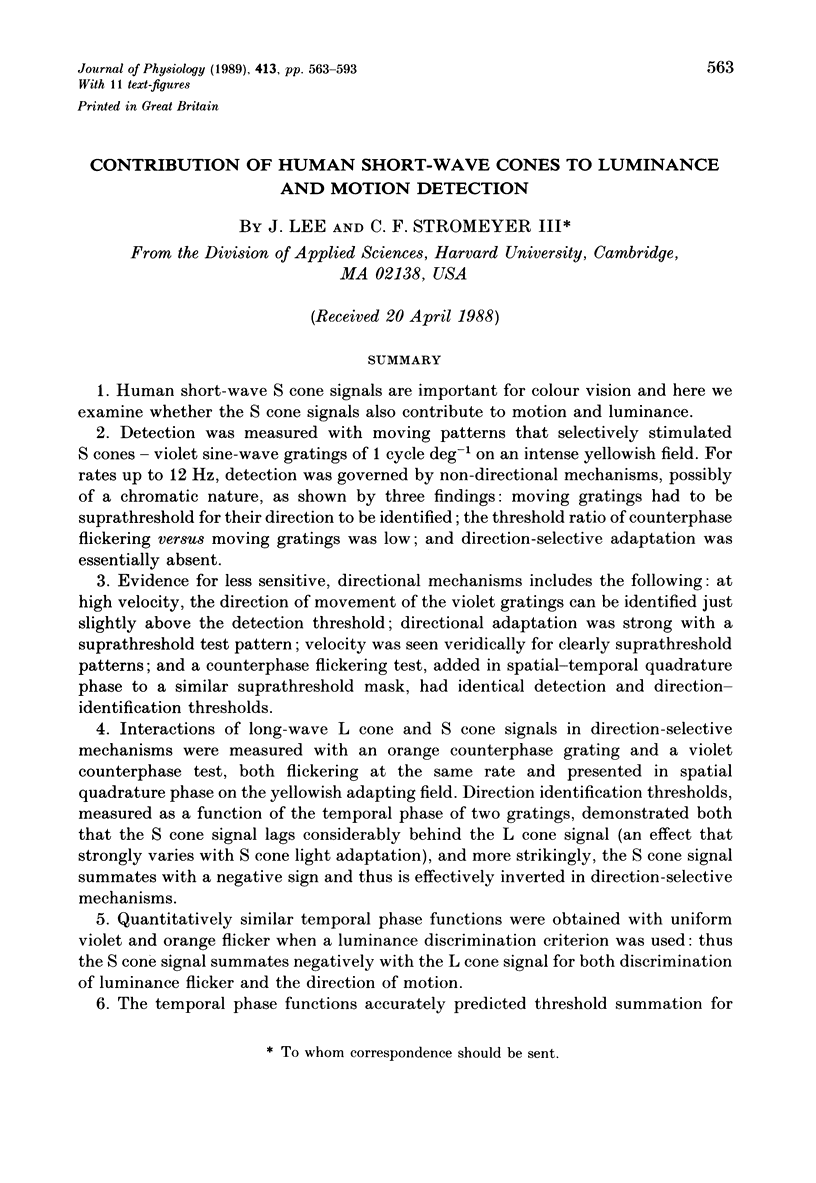
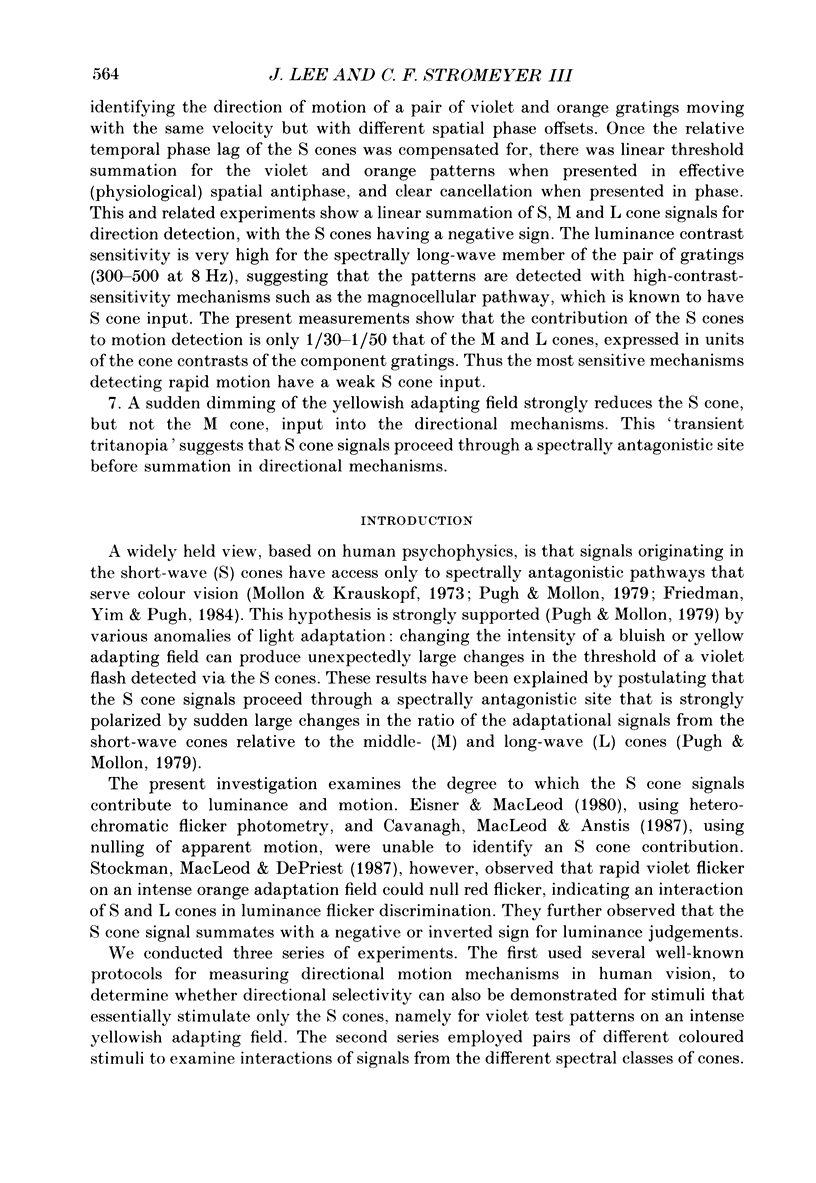
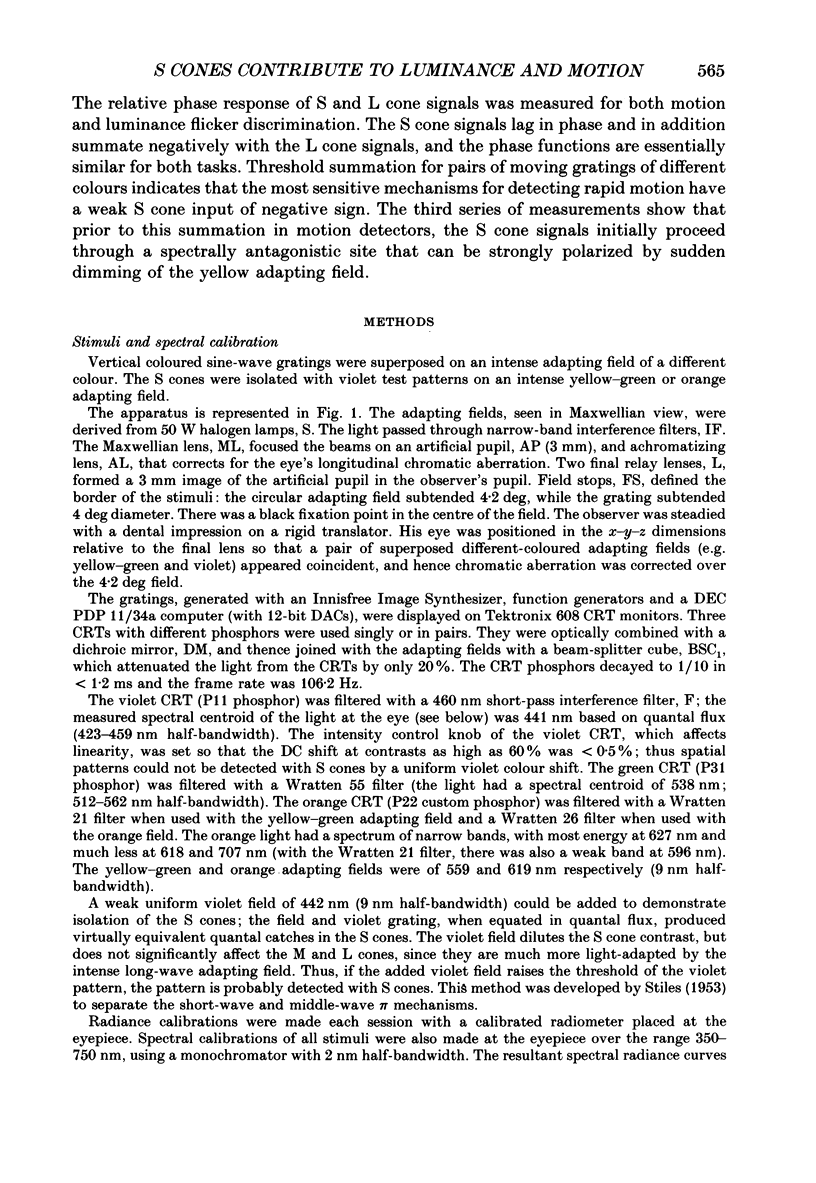
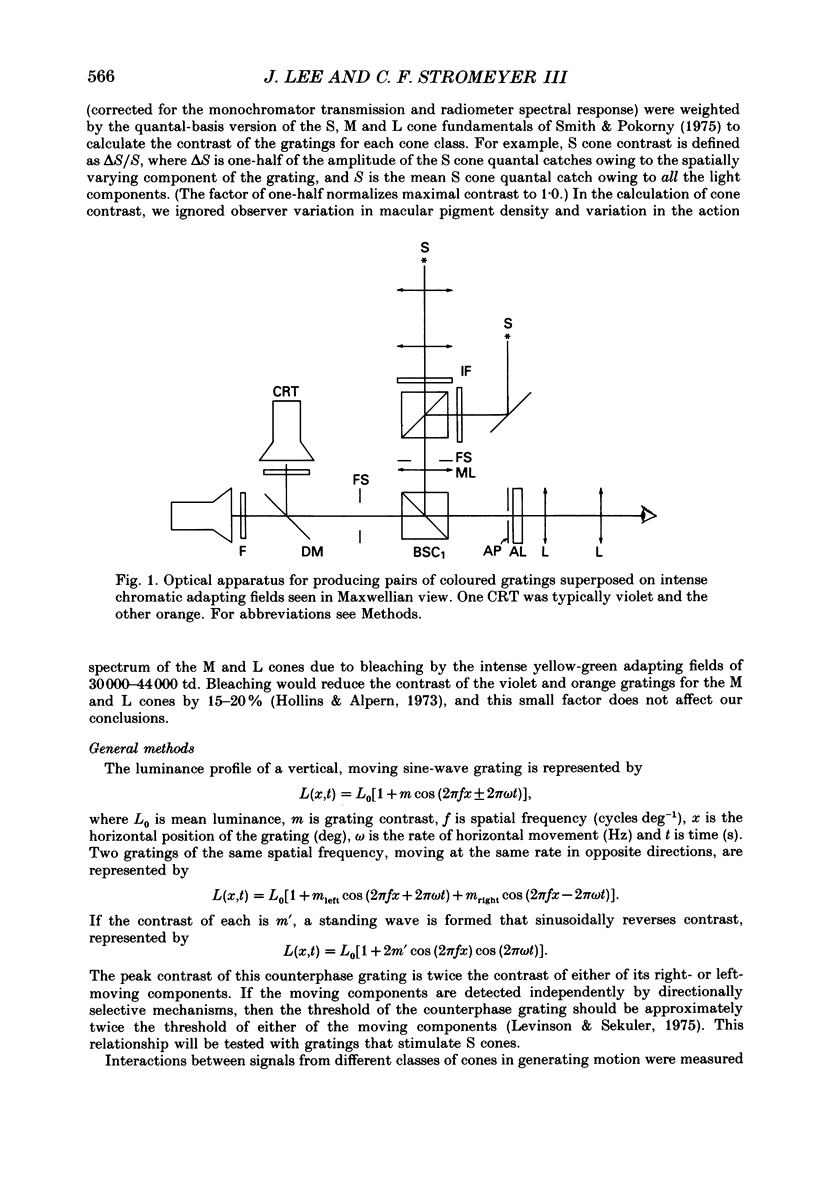
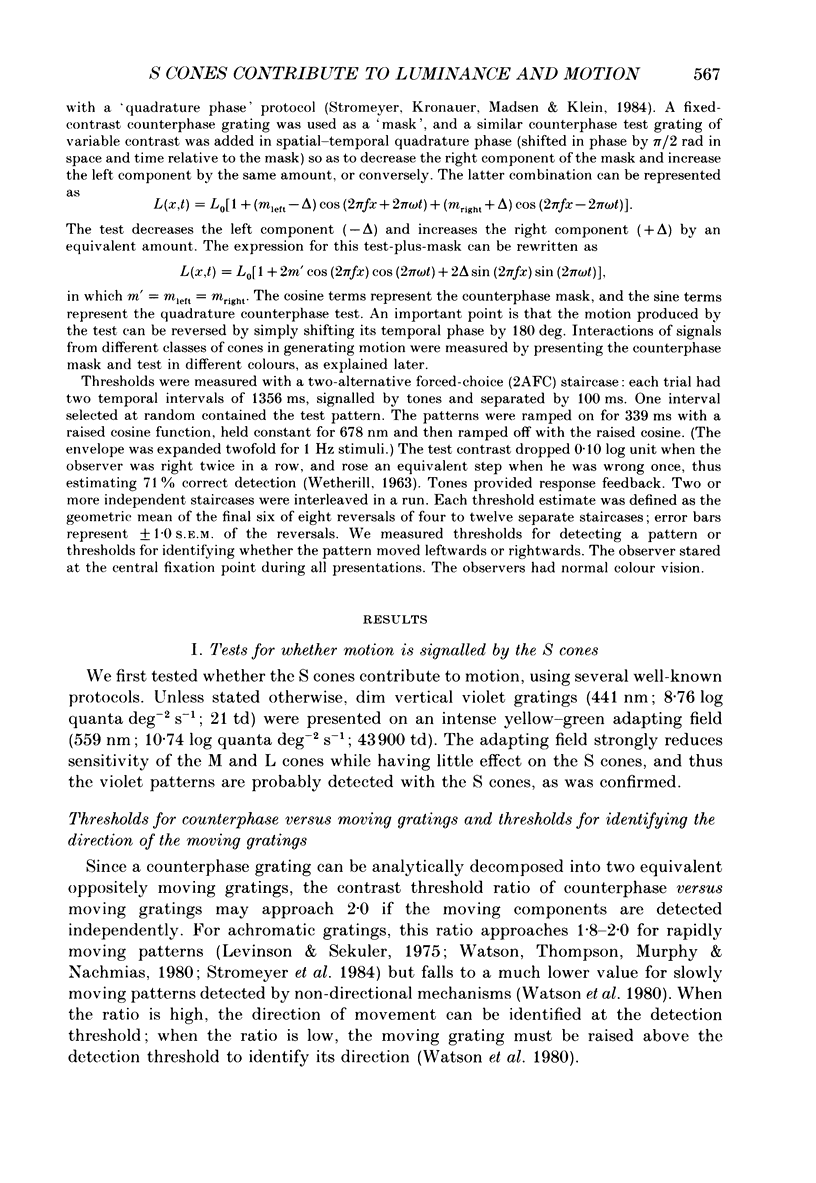
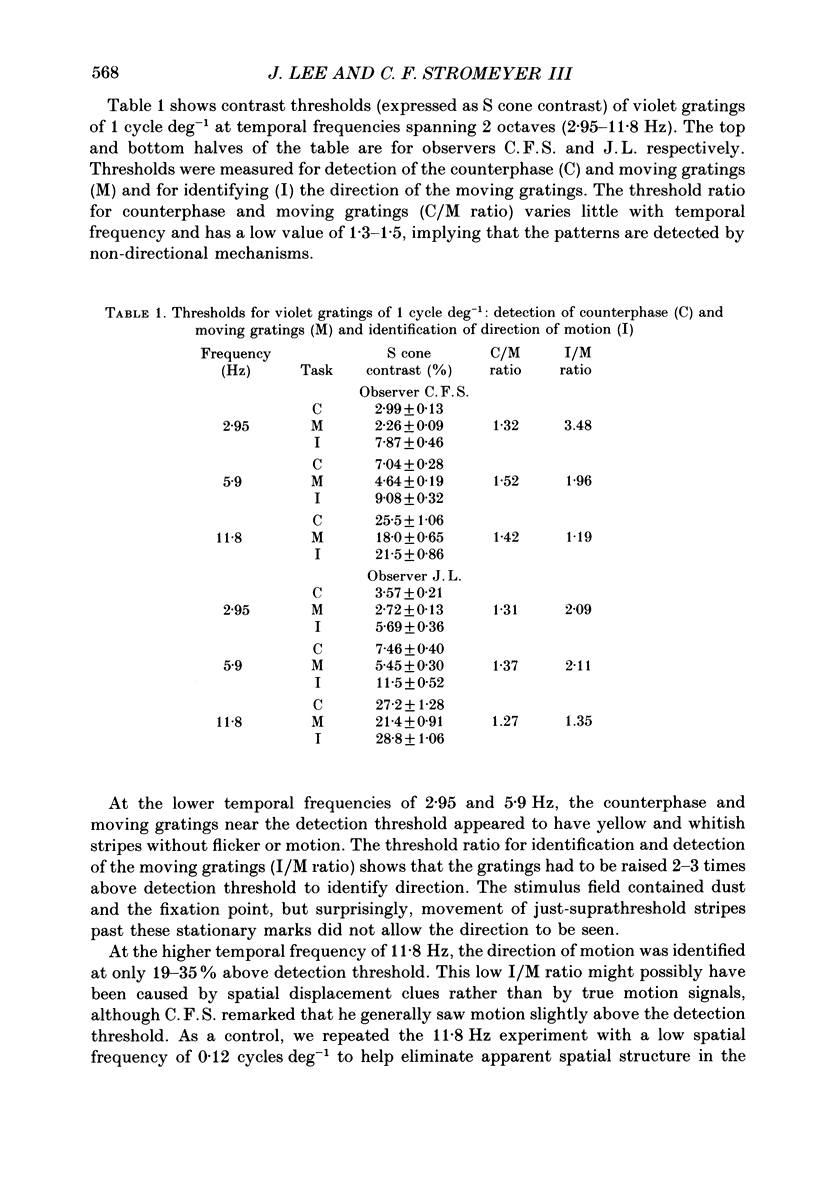
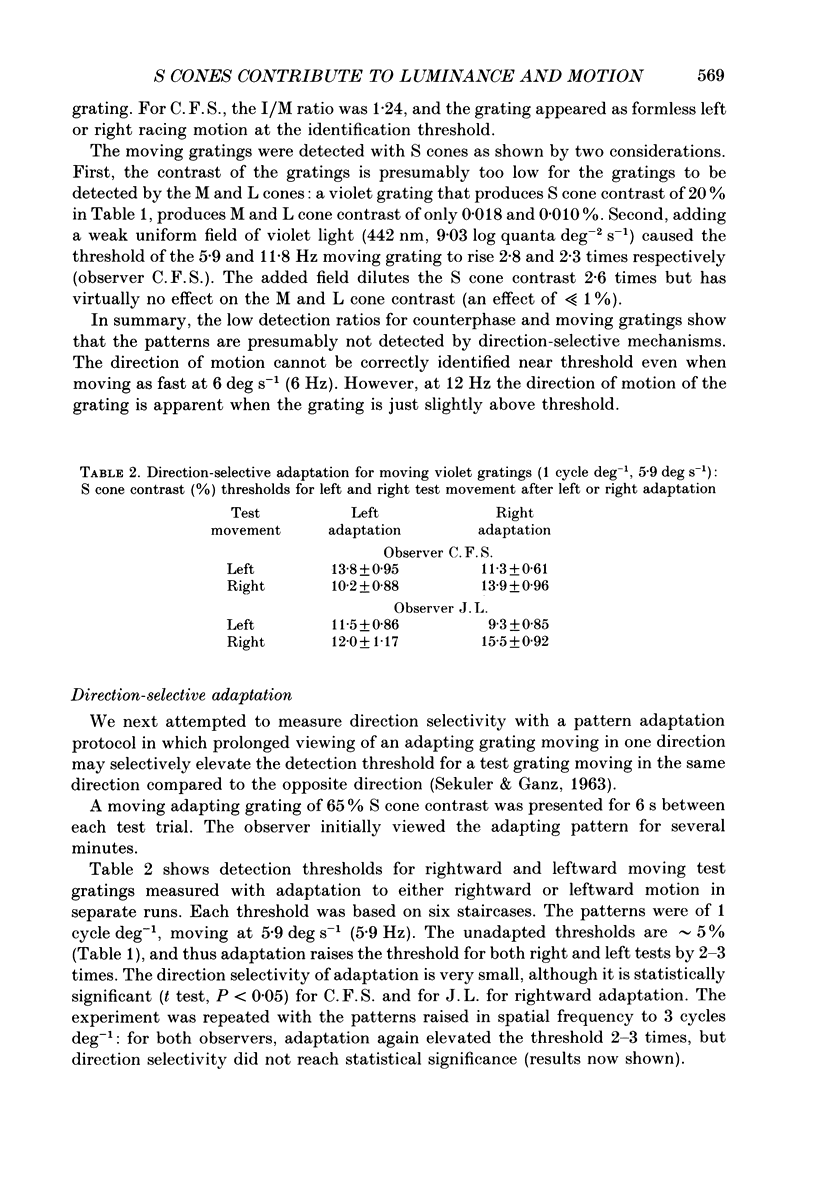
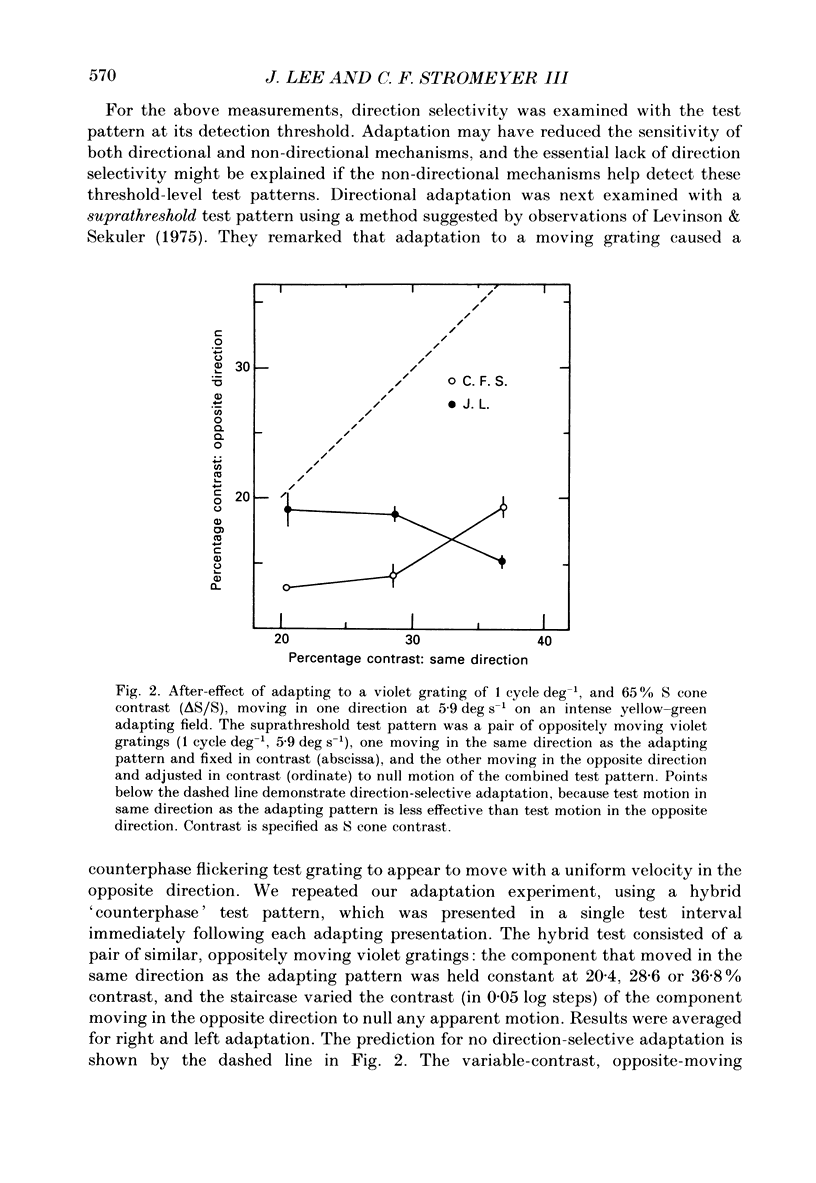
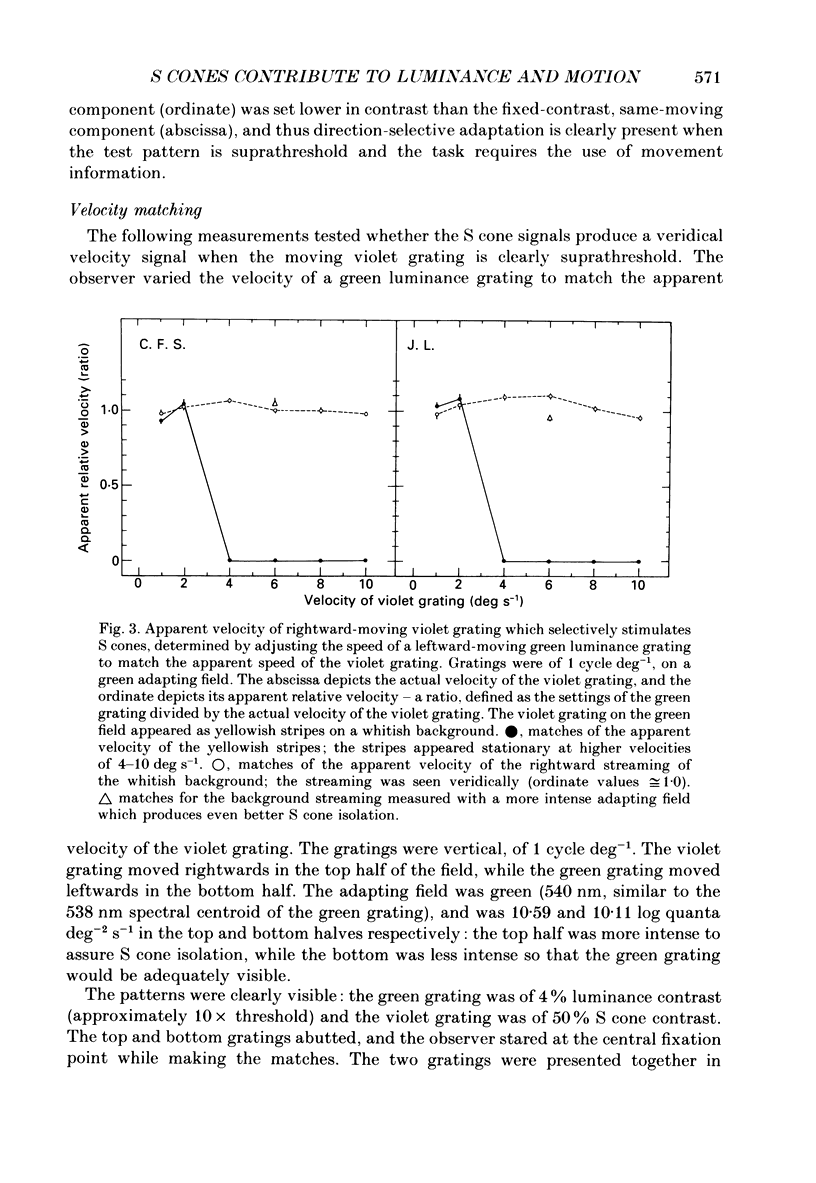
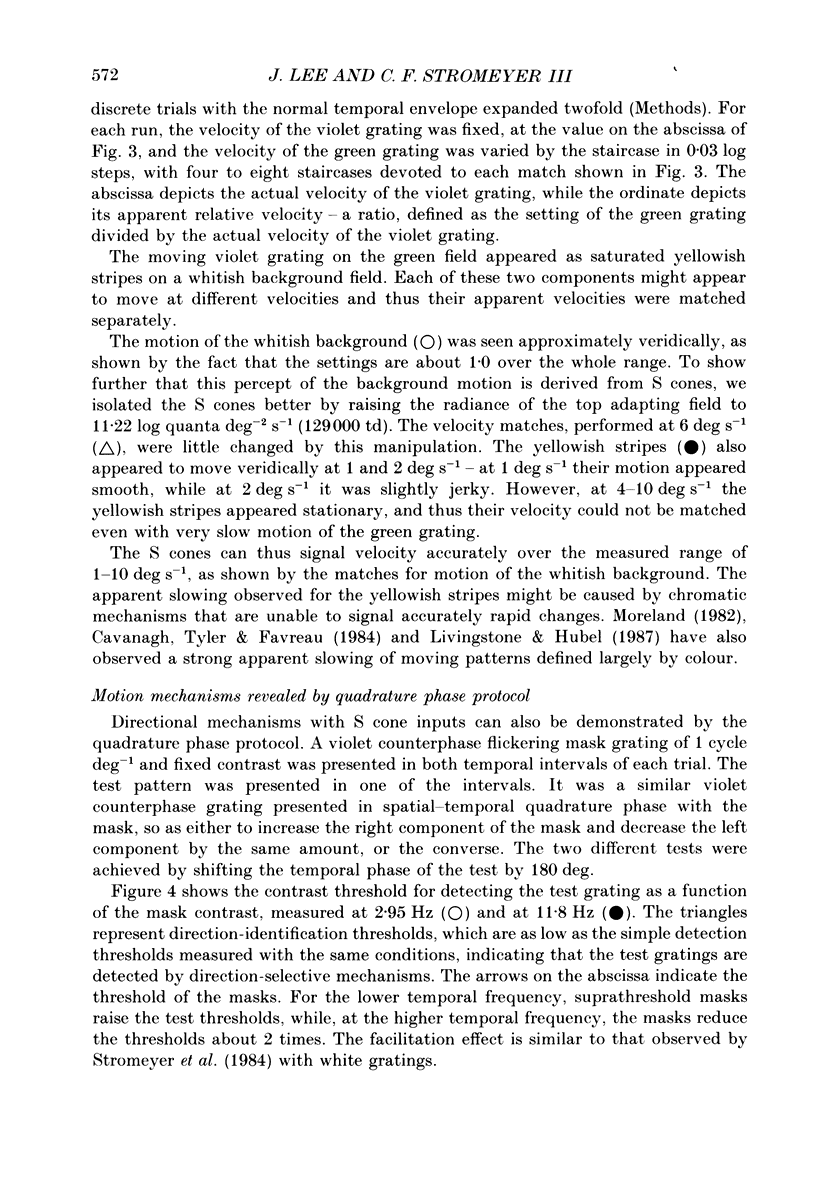
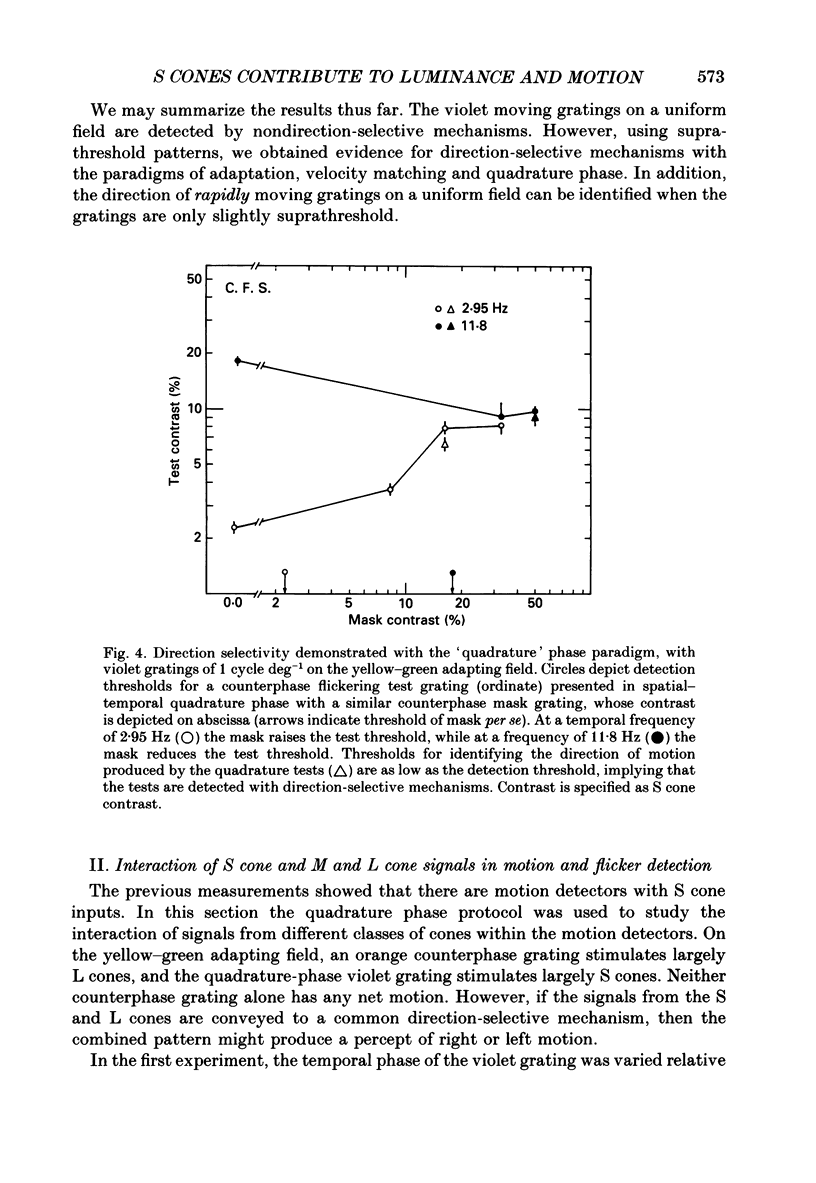
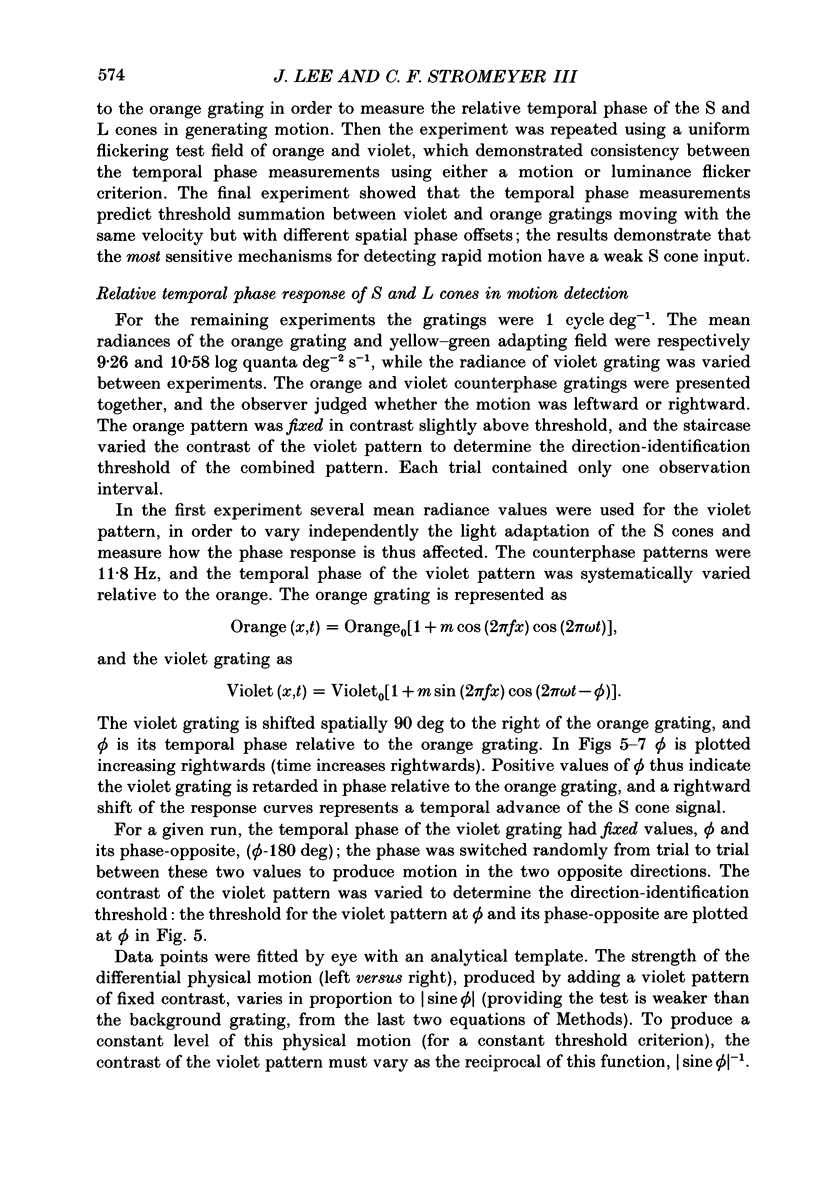
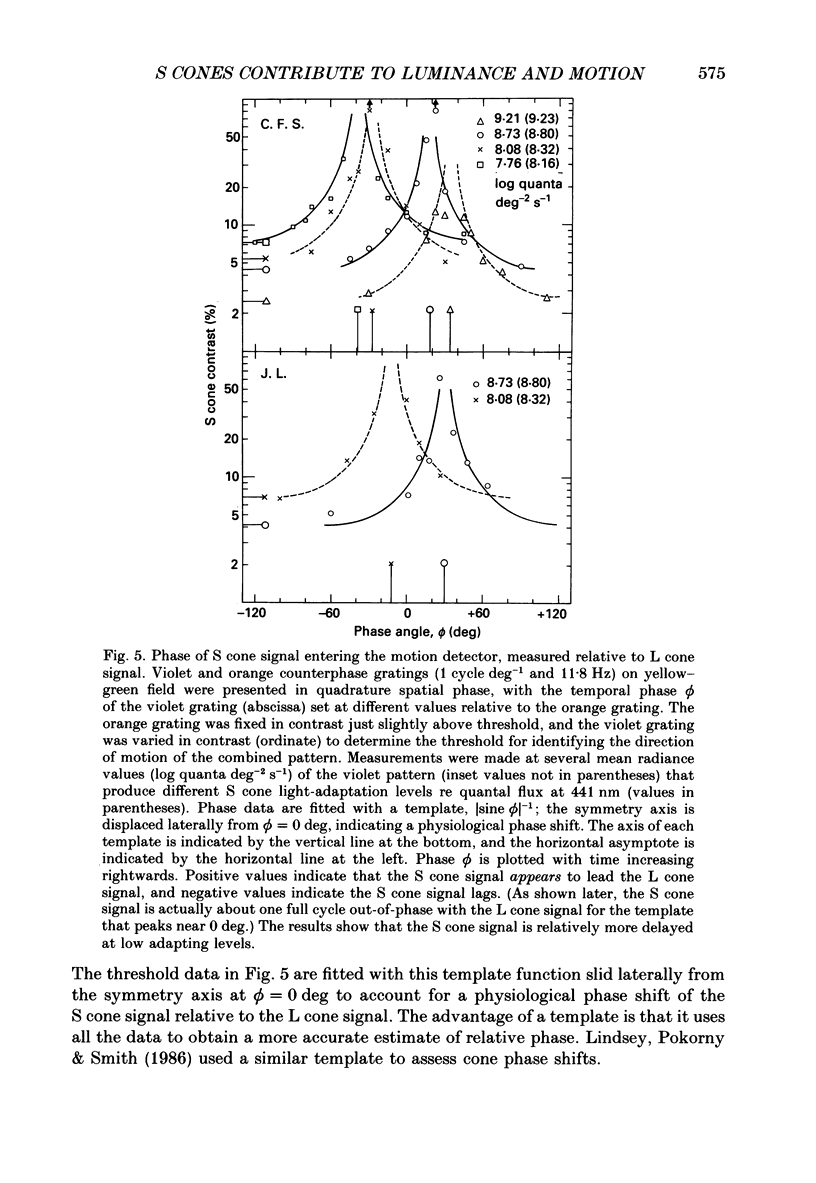
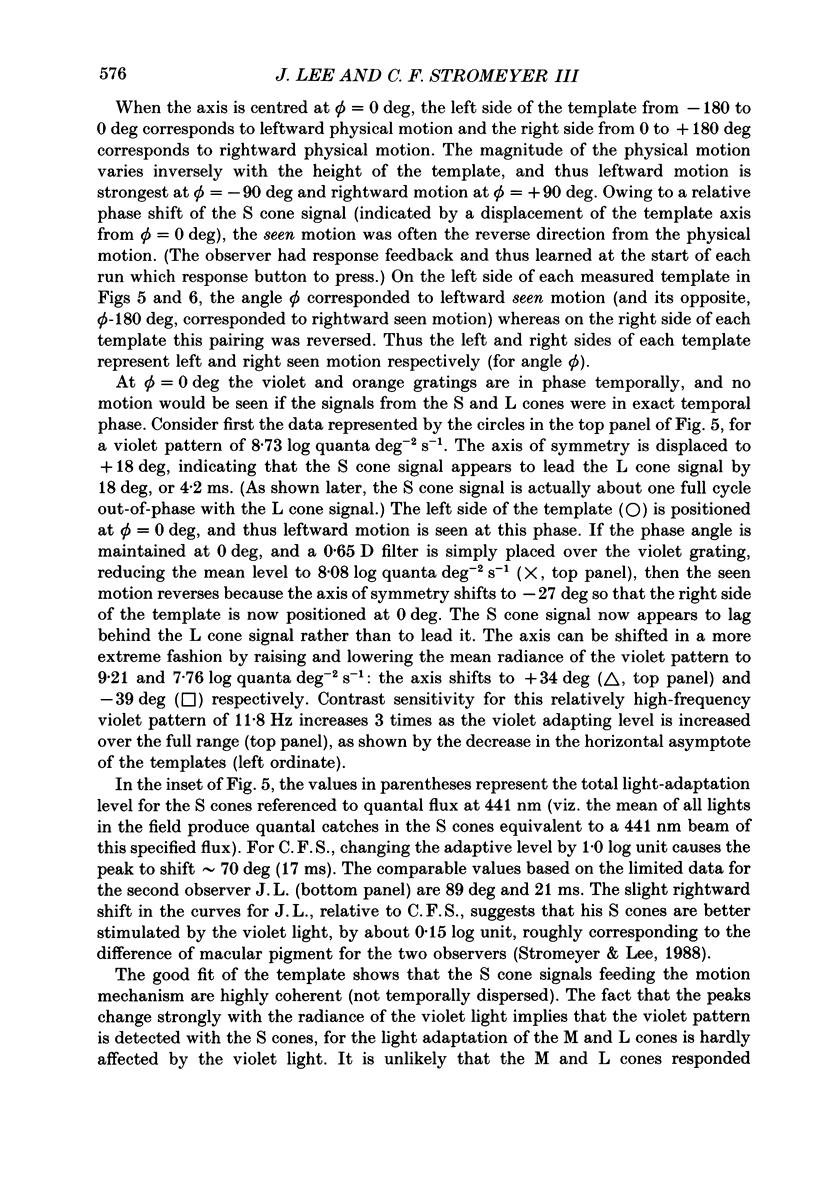
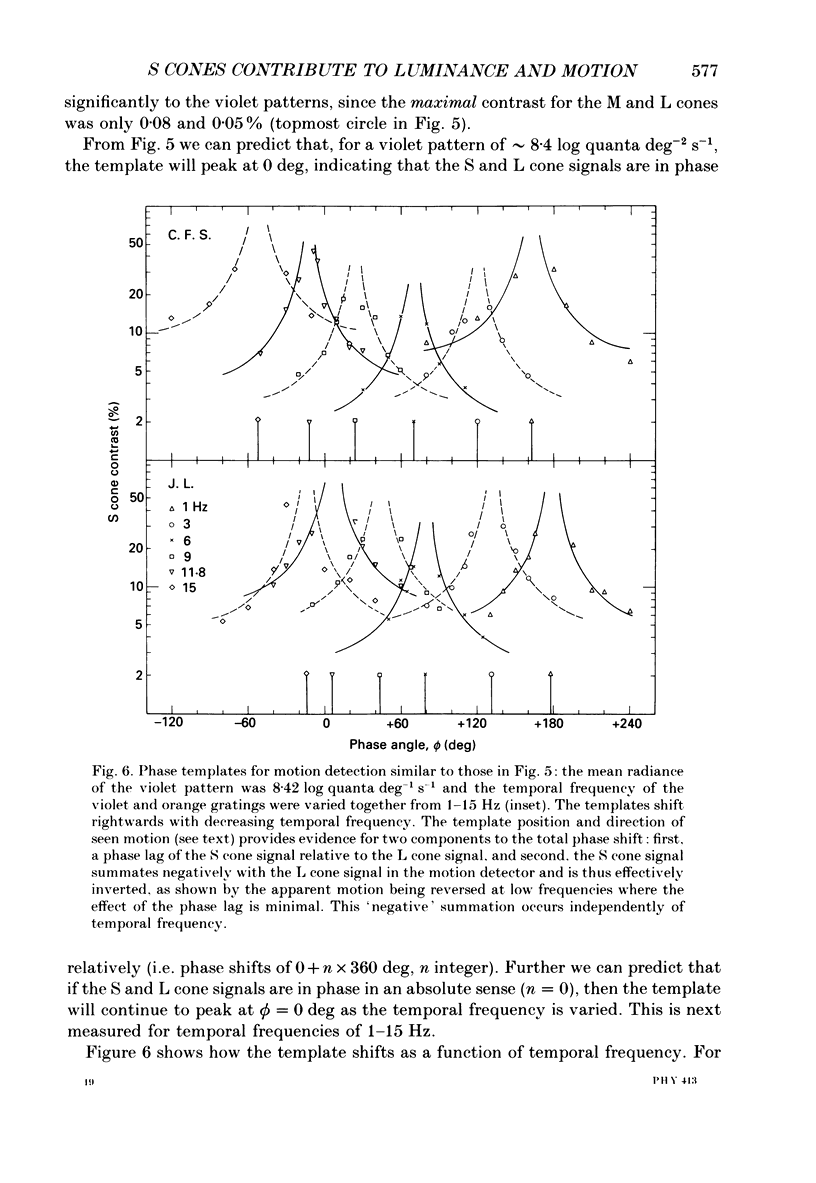
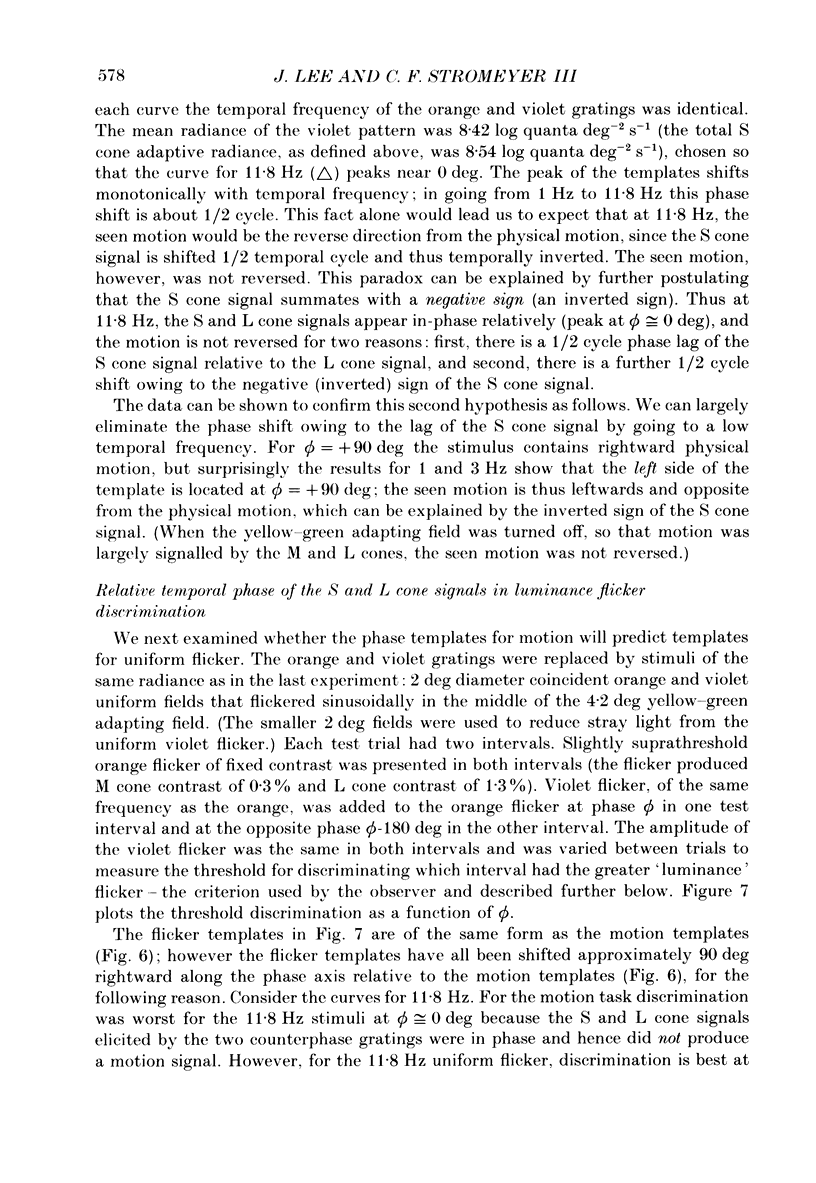
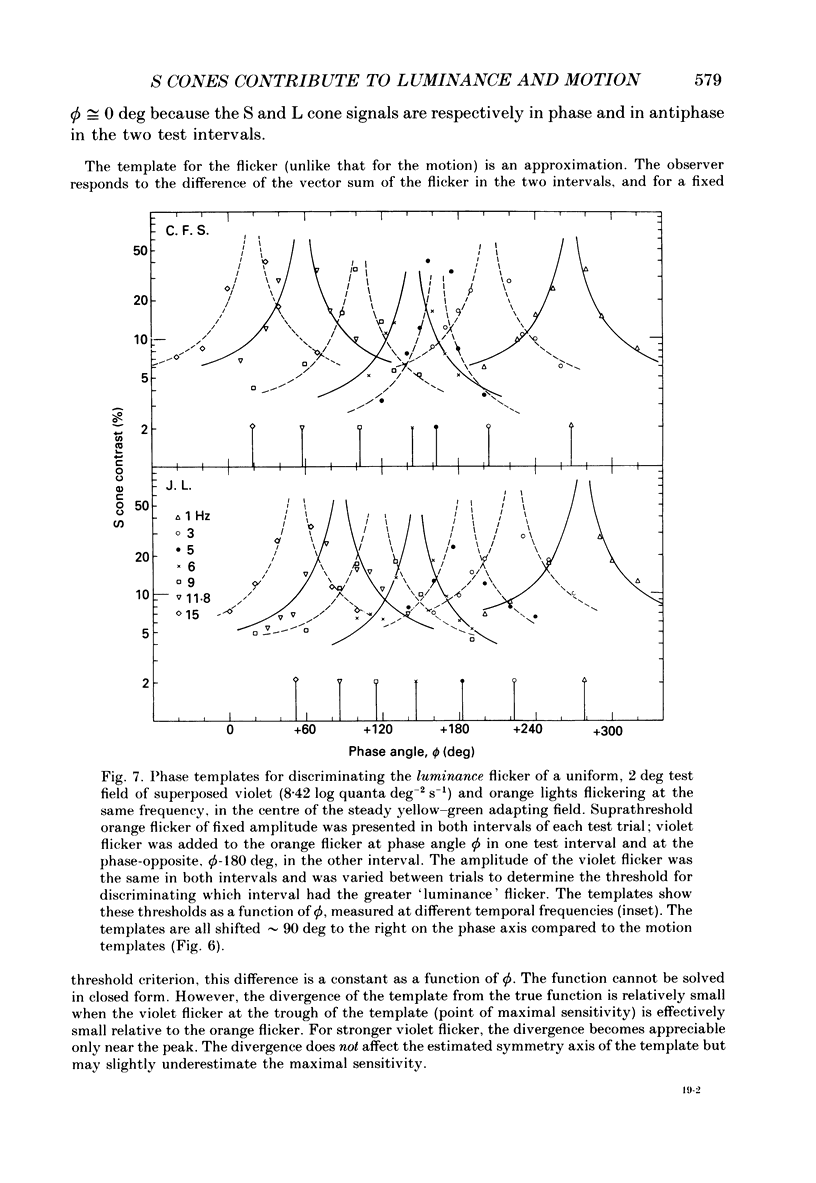
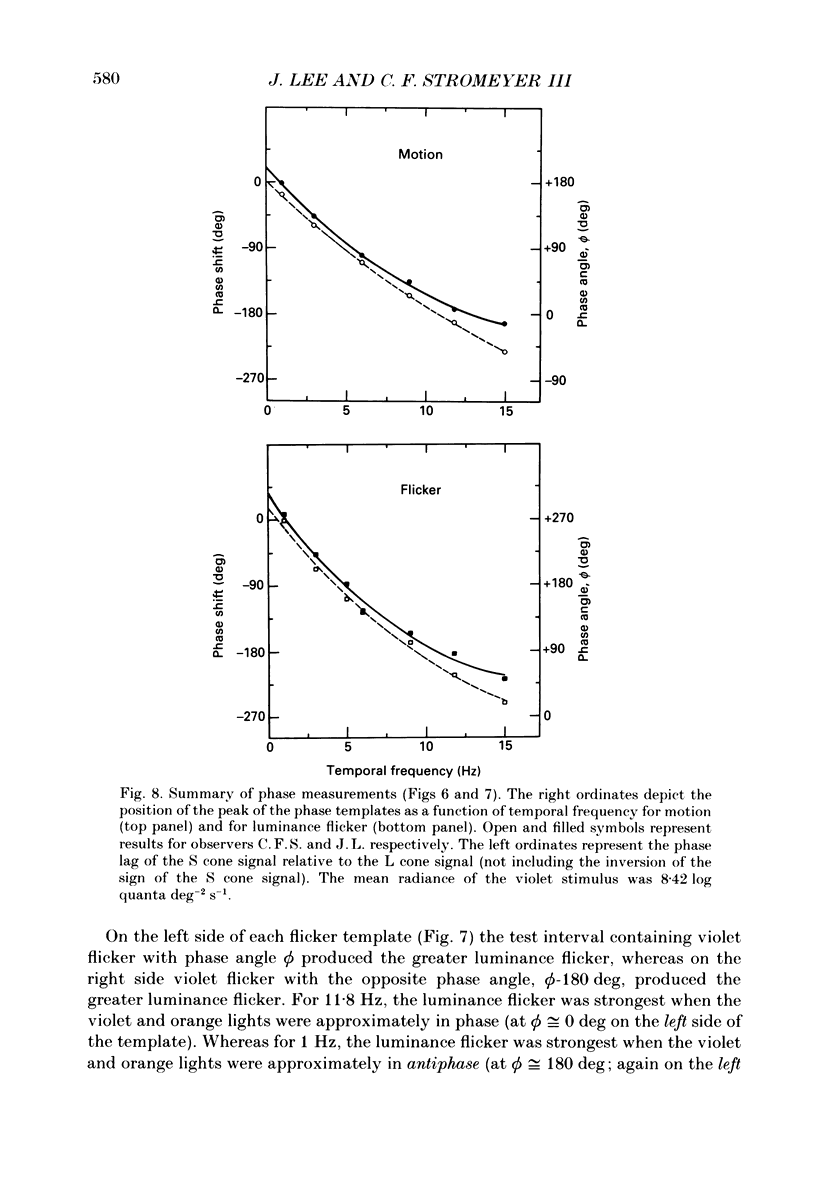
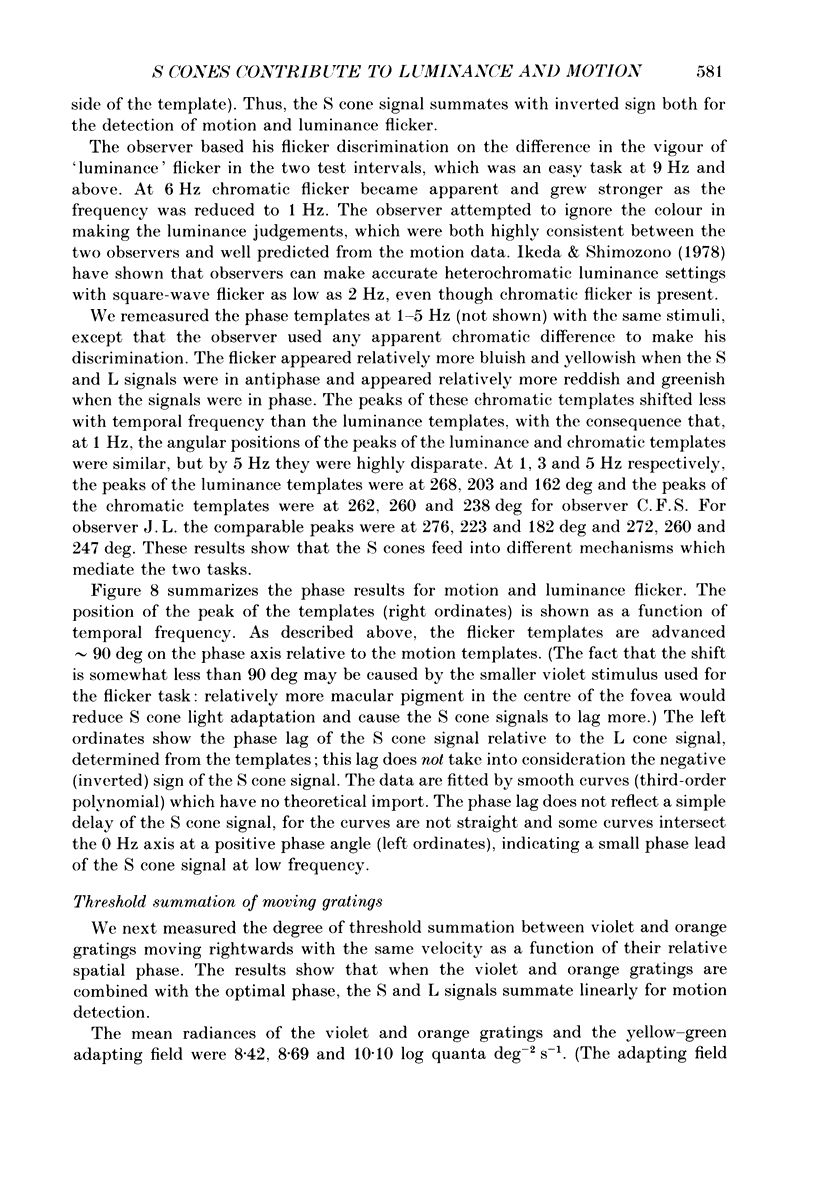
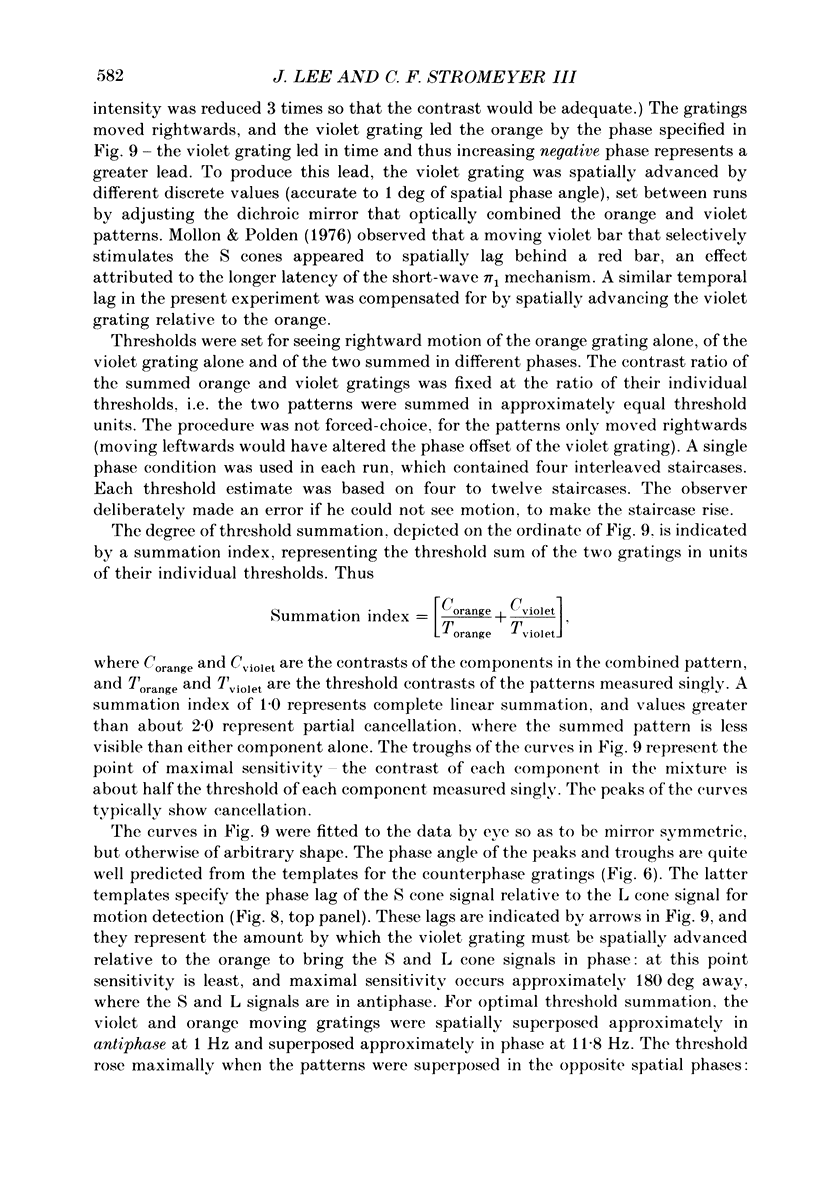
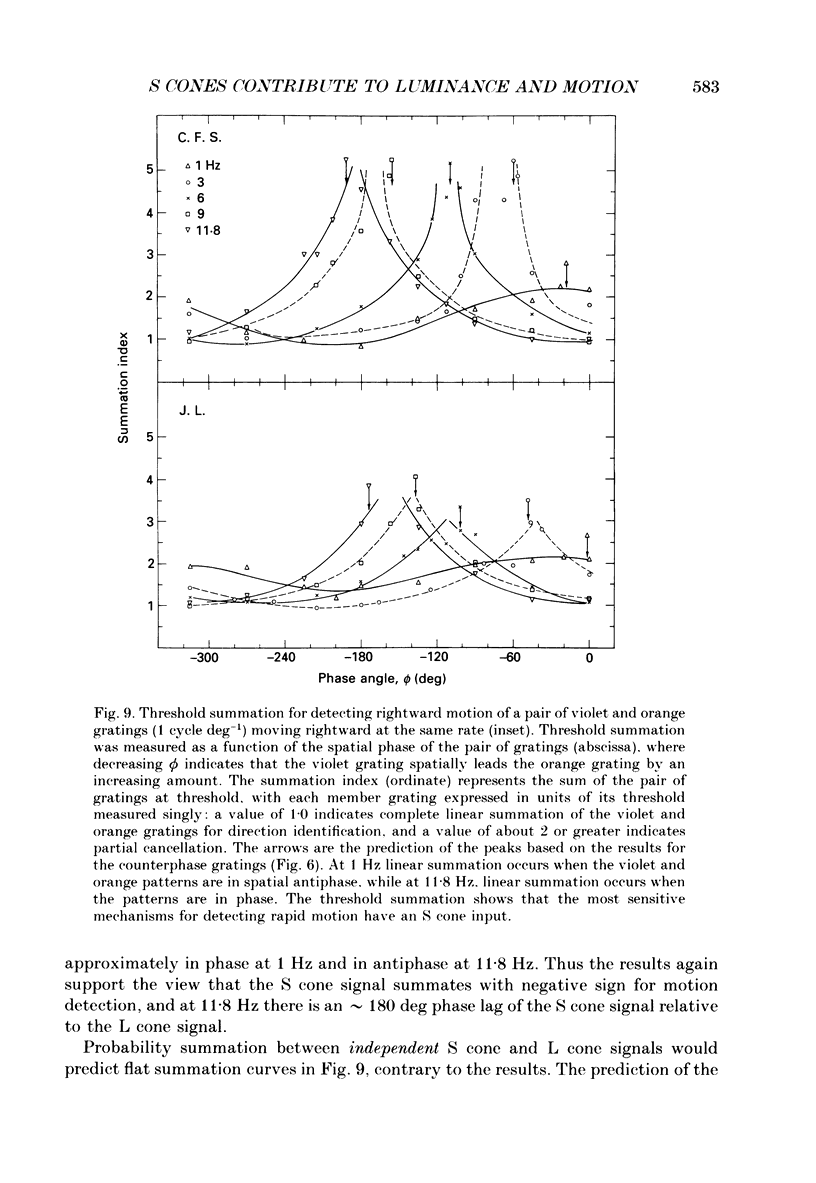
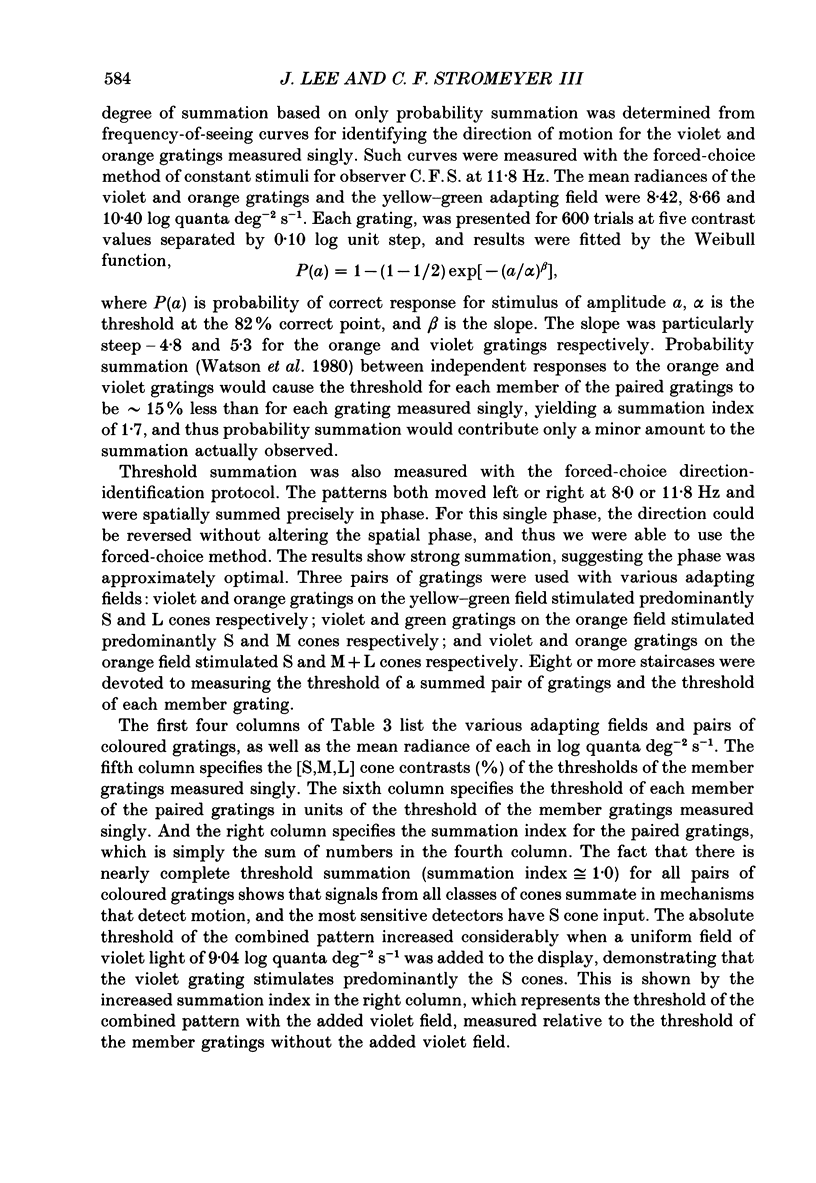
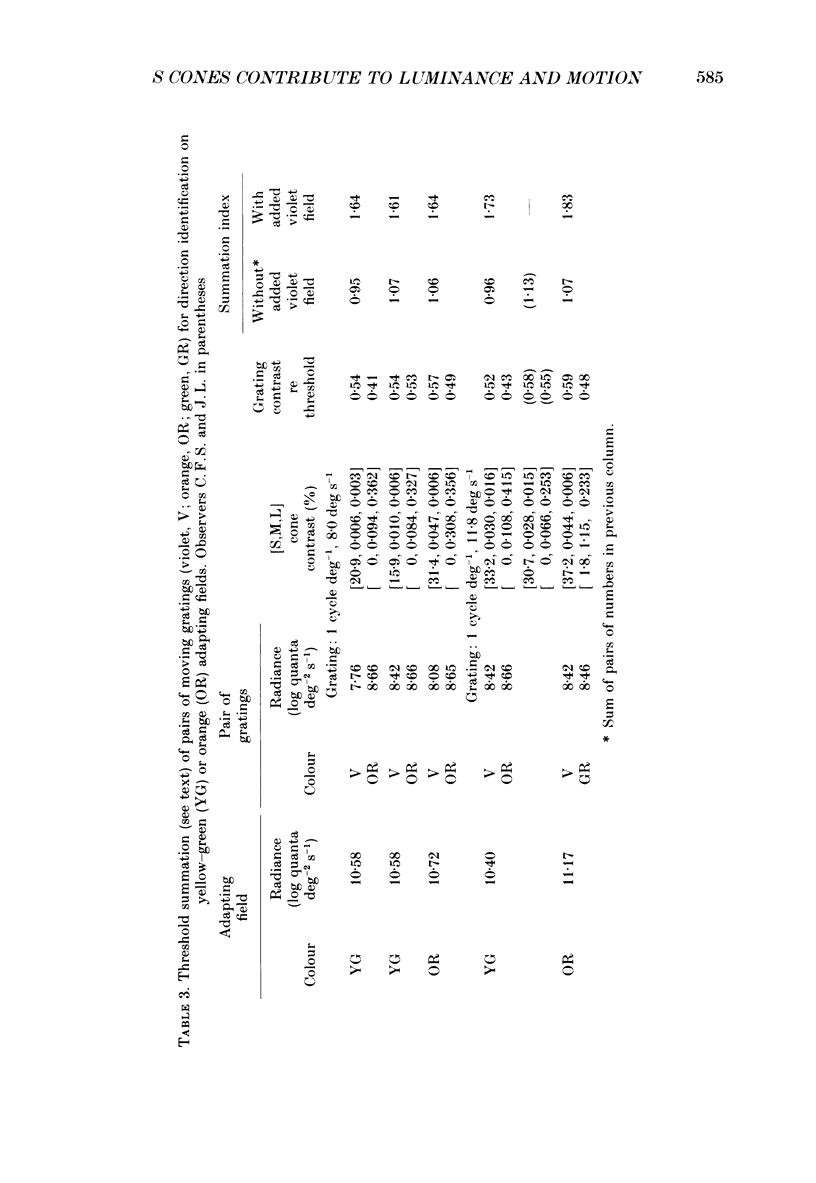
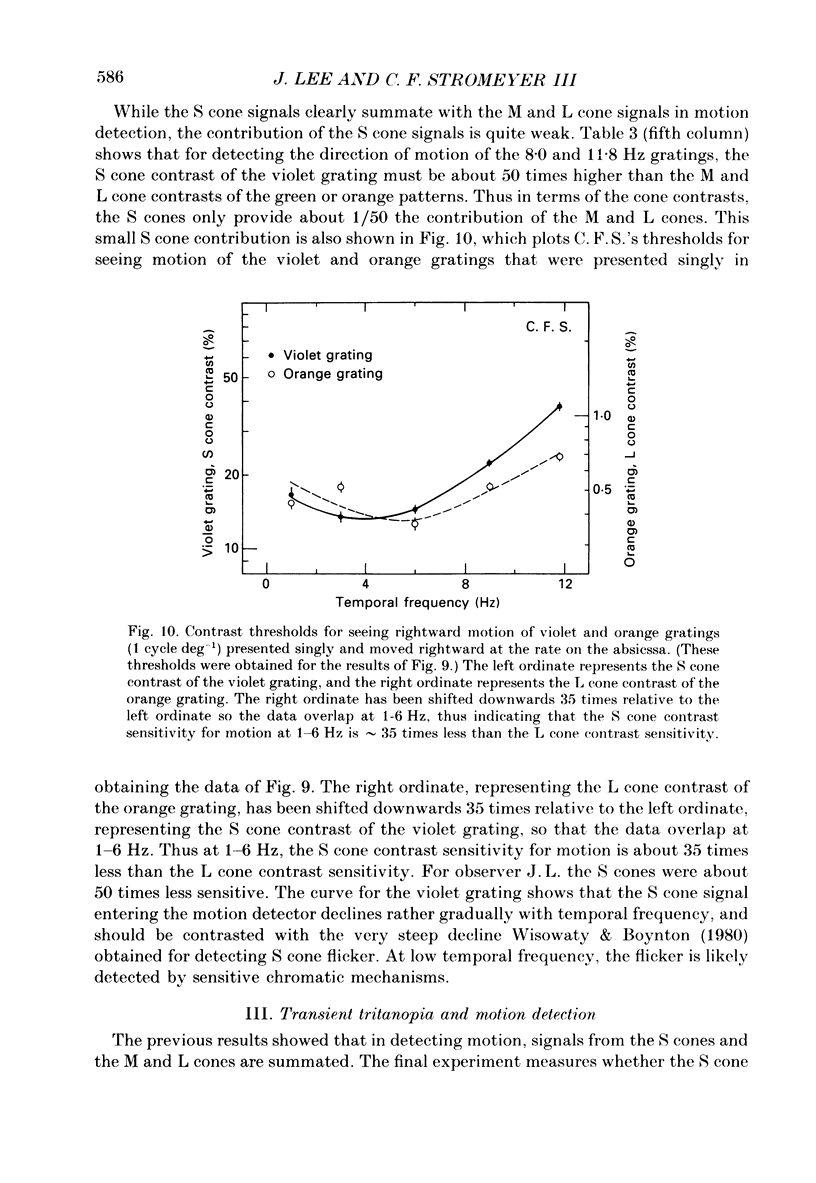
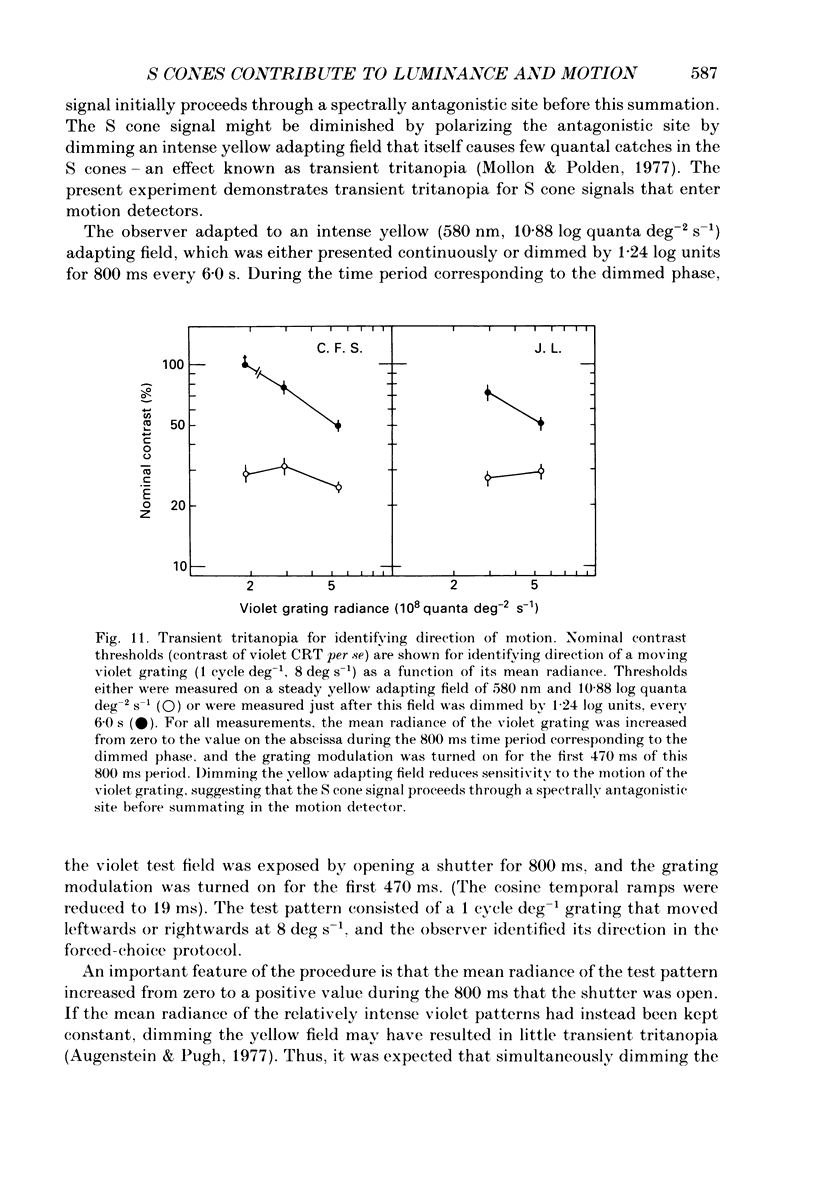
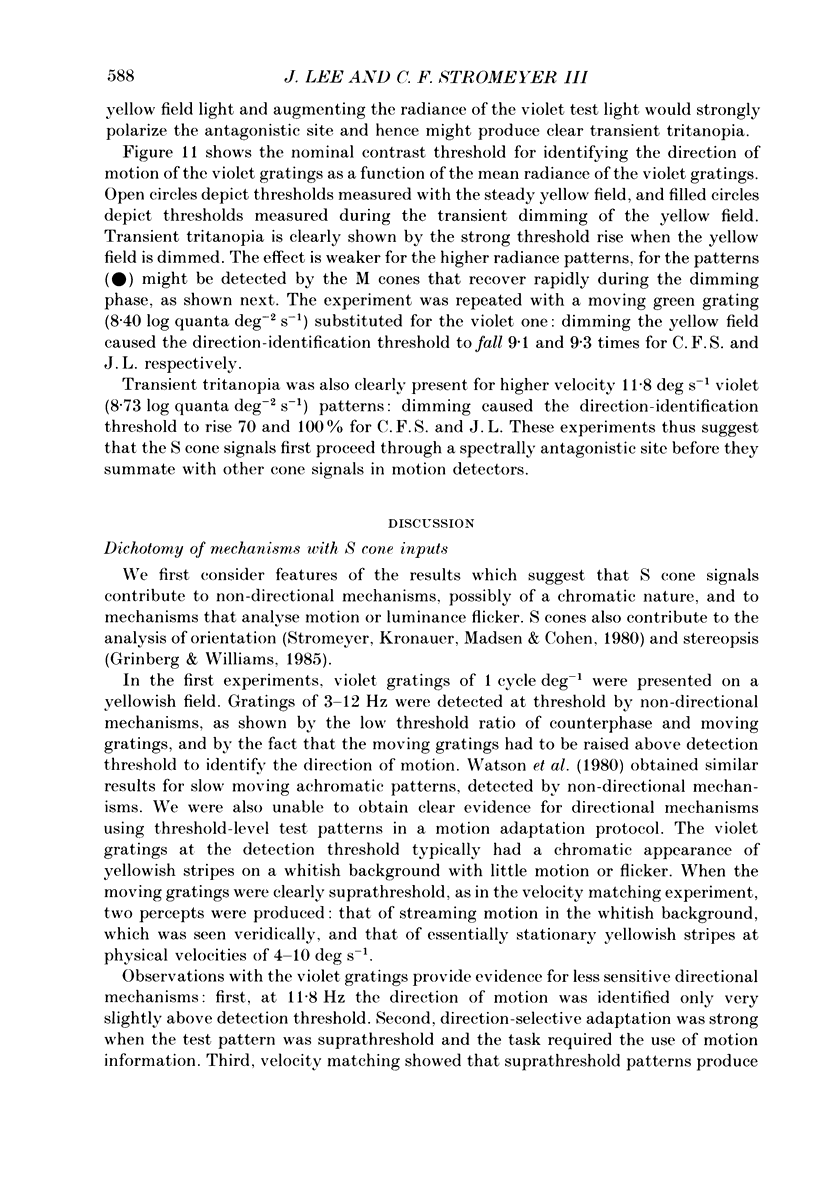
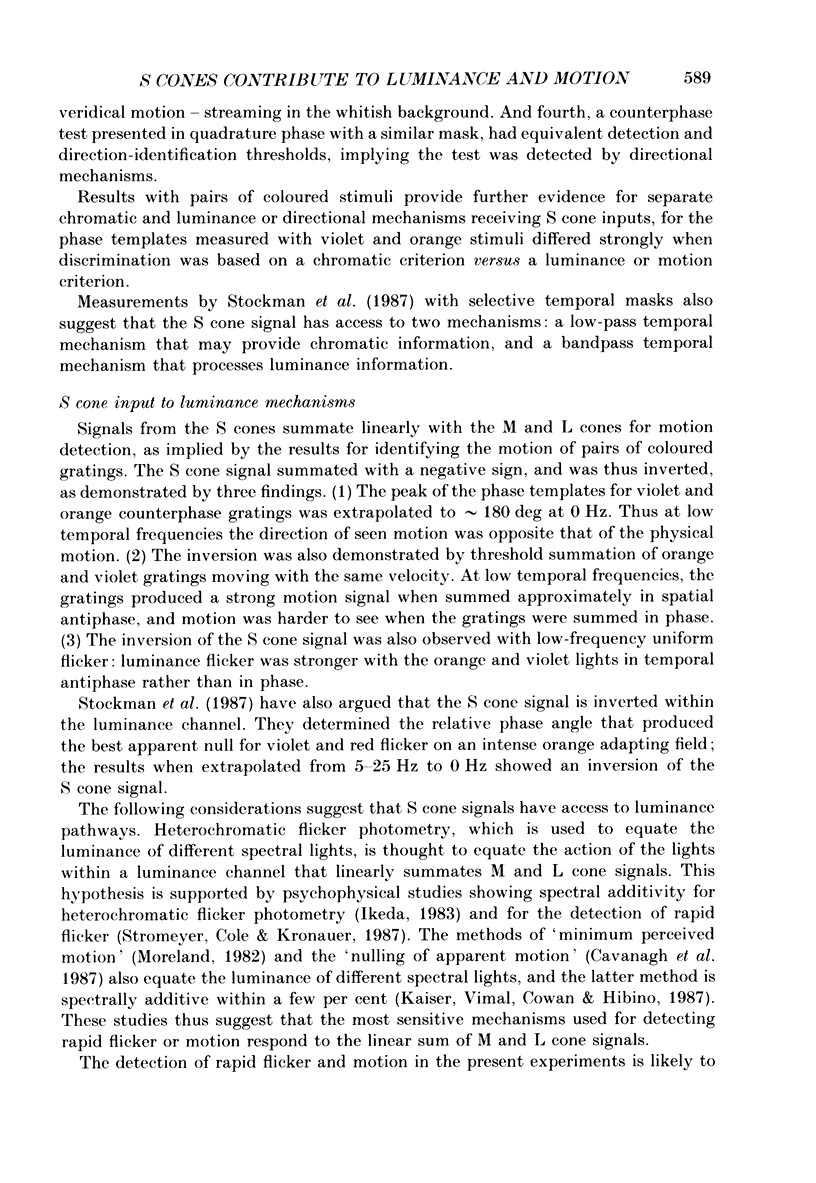
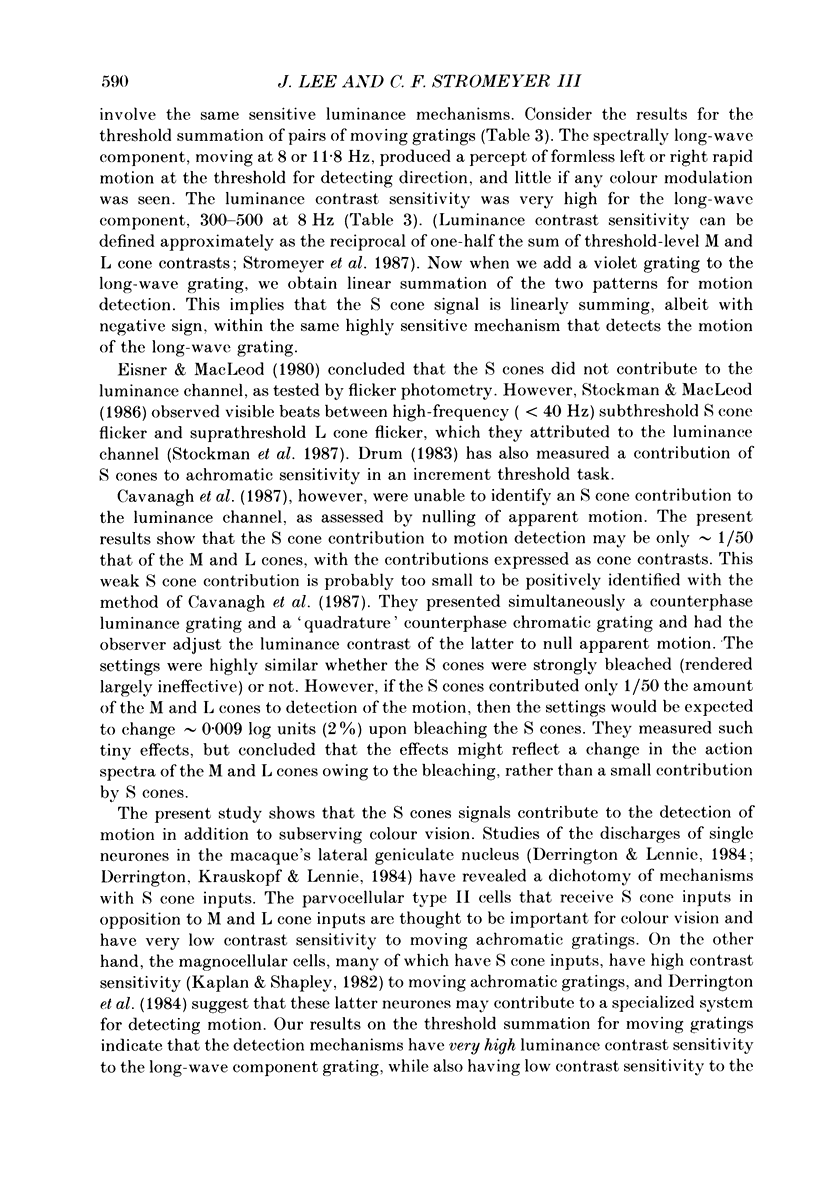
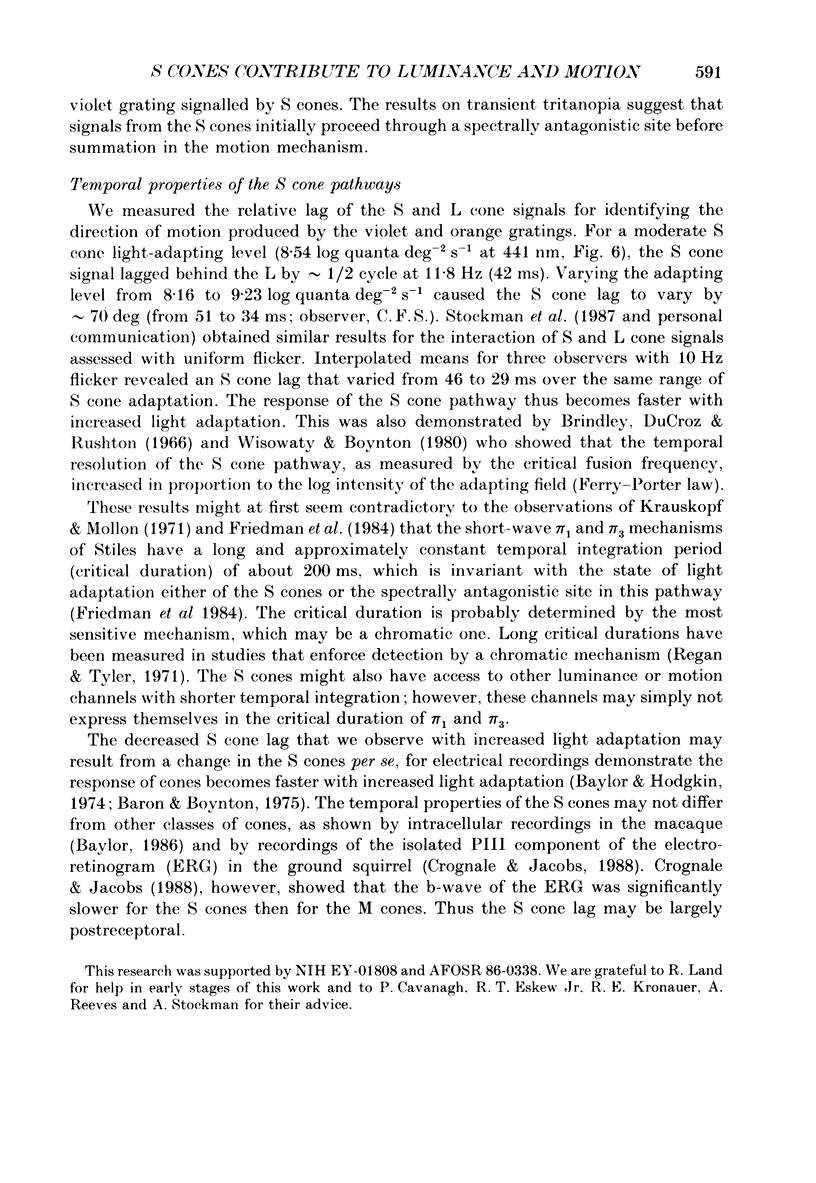
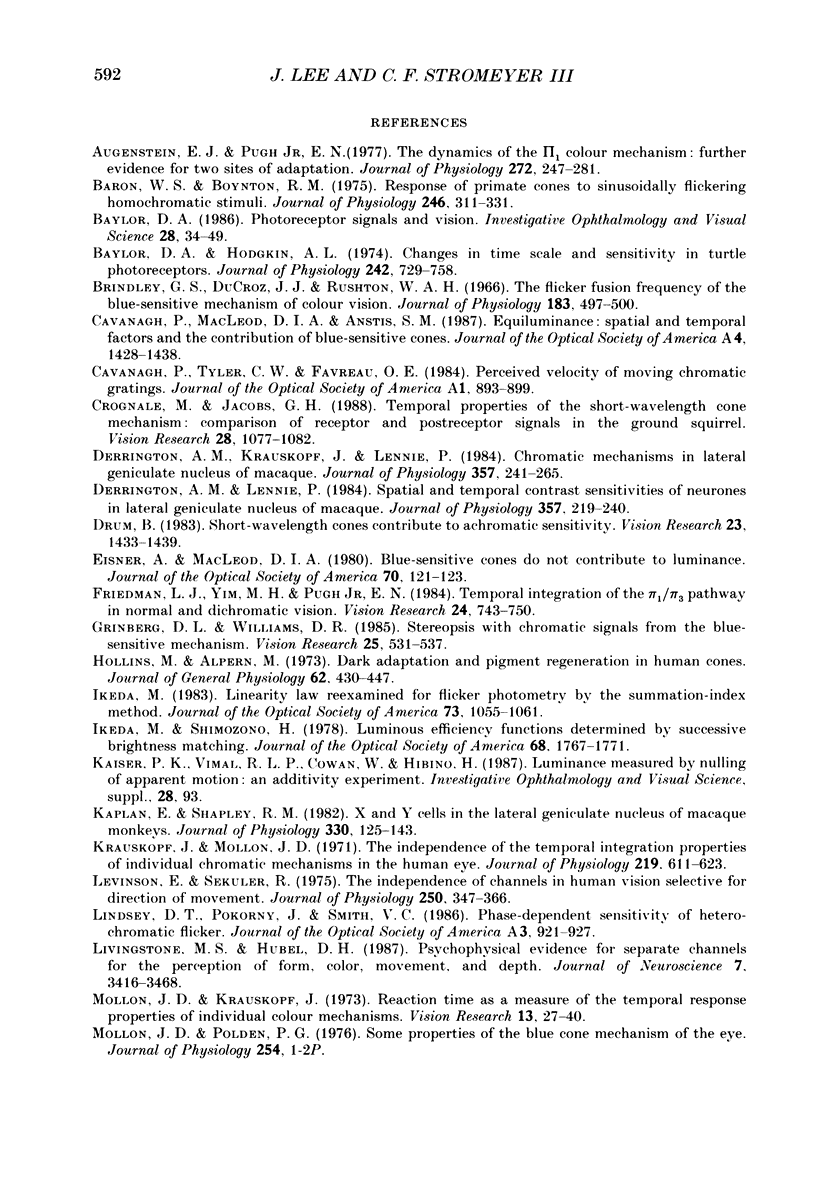
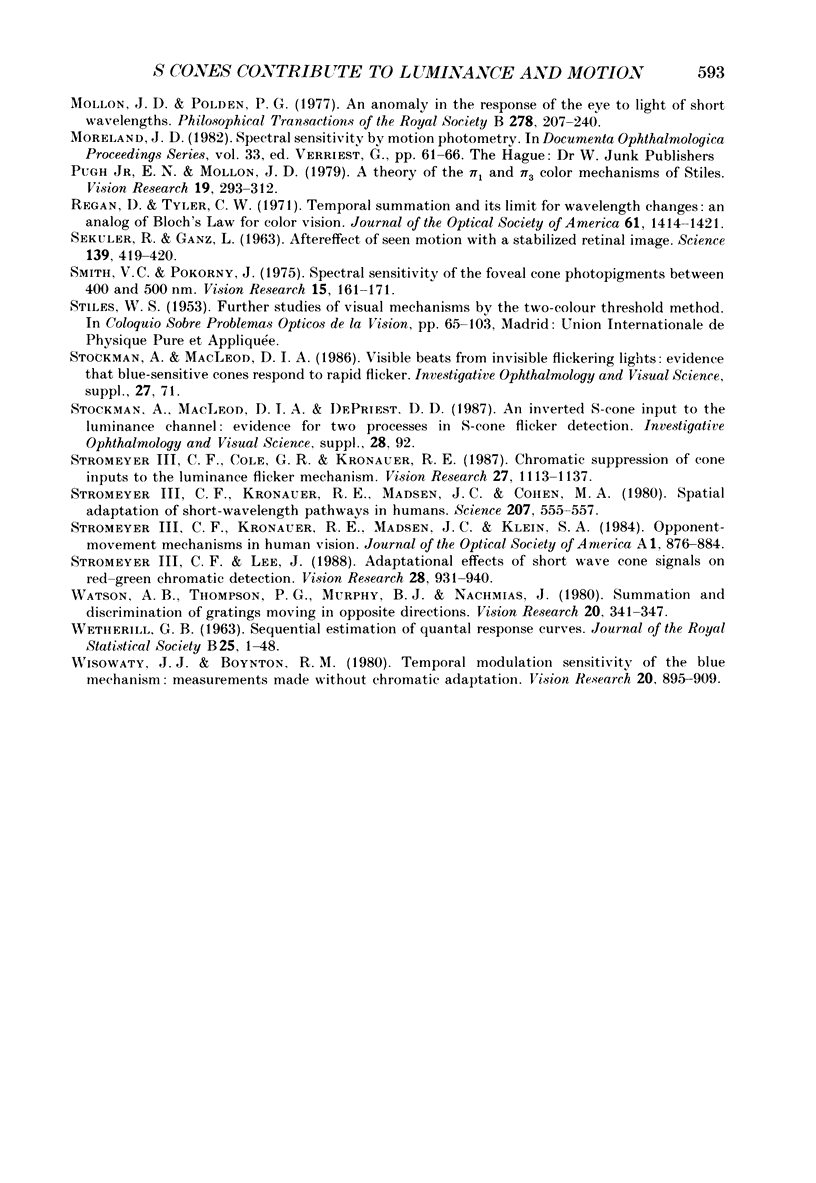
Selected References
These references are in PubMed. This may not be the complete list of references from this article.
- Augenstein E. J., Pugh E. N., Jr The dynamics of the pi 1 colour mechanism: further evidence for two sites of adaptation. J Physiol. 1977 Nov;272(2):247–281. doi: 10.1113/jphysiol.1977.sp012043. [DOI] [PMC free article] [PubMed] [Google Scholar]
- Baron W. S., Boynton R. M. Response of primate cones to sinusoidally flickering homochromatic stimuli. J Physiol. 1975 Mar;246(2):311–331. doi: 10.1113/jphysiol.1975.sp010892. [DOI] [PMC free article] [PubMed] [Google Scholar]
- Baylor D. A., Hodgkin A. L. Changes in time scale and sensitivity in turtle photoreceptors. J Physiol. 1974 Nov;242(3):729–758. doi: 10.1113/jphysiol.1974.sp010732. [DOI] [PMC free article] [PubMed] [Google Scholar]
- Baylor D. A. Photoreceptor signals and vision. Proctor lecture. Invest Ophthalmol Vis Sci. 1987 Jan;28(1):34–49. [PubMed] [Google Scholar]
- Brindley G. S., Du Croz J. J., Rushton W. A. The flicker fusion frequency of the blue-sensitive mechanism of colour vision. J Physiol. 1966 Mar;183(2):497–500. doi: 10.1113/jphysiol.1966.sp007879. [DOI] [PMC free article] [PubMed] [Google Scholar]
- Cavanagh P., MacLeod D. I., Anstis S. M. Equiluminance: spatial and temporal factors and the contribution of blue-sensitive cones. J Opt Soc Am A. 1987 Aug;4(8):1428–1438. doi: 10.1364/josaa.4.001428. [DOI] [PubMed] [Google Scholar]
- Cavanagh P., Tyler C. W., Favreau O. E. Perceived velocity of moving chromatic gratings. J Opt Soc Am A. 1984 Aug;1(8):893–899. doi: 10.1364/josaa.1.000893. [DOI] [PubMed] [Google Scholar]
- Crognale M., Jacobs G. H. Temporal properties of the short-wavelength cone mechanism: comparison of receptor and postreceptor signals in the ground squirrel. Vision Res. 1988;28(10):1077–1082. doi: 10.1016/0042-6989(88)90134-4. [DOI] [PubMed] [Google Scholar]
- Derrington A. M., Krauskopf J., Lennie P. Chromatic mechanisms in lateral geniculate nucleus of macaque. J Physiol. 1984 Dec;357:241–265. doi: 10.1113/jphysiol.1984.sp015499. [DOI] [PMC free article] [PubMed] [Google Scholar]
- Derrington A. M., Lennie P. Spatial and temporal contrast sensitivities of neurones in lateral geniculate nucleus of macaque. J Physiol. 1984 Dec;357:219–240. doi: 10.1113/jphysiol.1984.sp015498. [DOI] [PMC free article] [PubMed] [Google Scholar]
- Drum B. Short-wavelength cones contribute to achromatic sensitivity. Vision Res. 1983;23(12):1433–1439. doi: 10.1016/0042-6989(83)90155-4. [DOI] [PubMed] [Google Scholar]
- Eisner A., MacLeod D. I. Blue-sensitive cones do not contribute to luminance. J Opt Soc Am. 1980 Jan;70(1):121–123. doi: 10.1364/josa.70.000121. [DOI] [PubMed] [Google Scholar]
- Friedman L. J., Yim M. H., Pugh E. N., Jr Temporal integration of the pi 1/pi 3 pathway in normal and dichromatic vision. Vision Res. 1984;24(7):743–750. doi: 10.1016/0042-6989(84)90215-3. [DOI] [PubMed] [Google Scholar]
- Grinberg D. L., Williams D. R. Stereopsis with chromatic signals from the blue-sensitive mechanism. Vision Res. 1985;25(4):531–537. doi: 10.1016/0042-6989(85)90156-7. [DOI] [PubMed] [Google Scholar]
- Hollins M., Alpern M. Dark adaptation and visual pigment regeneration in human cones. J Gen Physiol. 1973 Oct;62(4):430–447. doi: 10.1085/jgp.62.4.430. [DOI] [PMC free article] [PubMed] [Google Scholar]
- Ikeda M. Linearity law reexamined for flicker photometry by the summation-index method. J Opt Soc Am. 1983 Aug;73(8):1055–1061. doi: 10.1364/josa.73.001055. [DOI] [PubMed] [Google Scholar]
- Kaplan E., Shapley R. M. X and Y cells in the lateral geniculate nucleus of macaque monkeys. J Physiol. 1982 Sep;330:125–143. doi: 10.1113/jphysiol.1982.sp014333. [DOI] [PMC free article] [PubMed] [Google Scholar]
- Krauskopf J., Mollon J. D. The independence of the temporal integration properties of individual chromatic mechanisms in the human eye. J Physiol. 1971 Dec;219(3):611–623. doi: 10.1113/jphysiol.1971.sp009680. [DOI] [PMC free article] [PubMed] [Google Scholar]
- Levinson E., Sekuler R. The independence of channels in human vision selective for direction of movement. J Physiol. 1975 Sep;250(2):347–366. doi: 10.1113/jphysiol.1975.sp011058. [DOI] [PMC free article] [PubMed] [Google Scholar]
- Lindsey D. T., Pokorny J., Smith V. C. Phase-dependent sensitivity to heterochromatic flicker. J Opt Soc Am A. 1986 Jul;3(7):921–927. doi: 10.1364/josaa.3.000921. [DOI] [PubMed] [Google Scholar]
- Livingstone M. S., Hubel D. H. Psychophysical evidence for separate channels for the perception of form, color, movement, and depth. J Neurosci. 1987 Nov;7(11):3416–3468. doi: 10.1523/JNEUROSCI.07-11-03416.1987. [DOI] [PMC free article] [PubMed] [Google Scholar]
- Mollon J. D., Krauskopf J. Reaction time as a measure of the temporal response properties of individua colour mechanisms. Vision Res. 1973 Jan;13(1):27–40. doi: 10.1016/0042-6989(73)90162-4. [DOI] [PubMed] [Google Scholar]
- Mollon J. D., Polden P. G. An anomaly in the response of the eye to light of short wavelengths. Philos Trans R Soc Lond B Biol Sci. 1977 Mar 29;278(960):207–240. doi: 10.1098/rstb.1977.0038. [DOI] [PubMed] [Google Scholar]
- Mollon J. D., Polden P. G. Proceedings: Some properties of the blue cone mechanism of the eye. J Physiol. 1976 Jan;254(1):1P–2P. [PMC free article] [PubMed] [Google Scholar]
- Pugh E. N., Jr, Mollon J. D. A theory of the pi1 and pi3 color mechanisms of Stiles. Vision Res. 1979;19(3):293–312. doi: 10.1016/0042-6989(79)90175-5. [DOI] [PubMed] [Google Scholar]
- Regan D., Tyler C. W. Temporal summation and its limit for wavelength changes: an analog of Bloch's law for color vision. J Opt Soc Am. 1971 Oct;61(10):1414–1421. doi: 10.1364/josa.61.001414. [DOI] [PubMed] [Google Scholar]
- SEKULER R. W., GANZ L. Aftereffect of seen motion with a stabilized retinal image. Science. 1963 Feb 1;139(3553):419–420. doi: 10.1126/science.139.3553.419. [DOI] [PubMed] [Google Scholar]
- Smith V. C., Pokorny J. Spectral sensitivity of the foveal cone photopigments between 400 and 500 nm. Vision Res. 1975 Feb;15(2):161–171. doi: 10.1016/0042-6989(75)90203-5. [DOI] [PubMed] [Google Scholar]
- Stromeyer C. F., 3rd, Cole G. R., Kronauer R. E. Chromatic suppression of cone inputs to the luminance flicker mechanism. Vision Res. 1987;27(7):1113–1137. doi: 10.1016/0042-6989(87)90026-5. [DOI] [PubMed] [Google Scholar]
- Stromeyer C. F., 3rd, Kronauer R. E., Madsen J. C., Cohen M. A. Spatial adaptation of short-wavelength pathways in humans. Science. 1980 Feb 1;207(4430):555–557. doi: 10.1126/science.7352270. [DOI] [PubMed] [Google Scholar]
- Stromeyer C. F., 3rd, Kronauer R. E., Madsen J. C., Klein S. A. Opponent-movement mechanisms in human vision. J Opt Soc Am A. 1984 Aug;1(8):876–884. doi: 10.1364/josaa.1.000876. [DOI] [PubMed] [Google Scholar]
- Stromeyer C. F., 3rd, Lee J. Adaptational effects of short wave cone signals on red-green chromatic detection. Vision Res. 1988;28(8):931–940. doi: 10.1016/0042-6989(88)90102-2. [DOI] [PubMed] [Google Scholar]
- Watson A. B., Thompson P. G., Murphy B. J., Nachmias J. Summation and discrimination of gratings moving in opposite directions. Vision Res. 1980;20(4):341–347. doi: 10.1016/0042-6989(80)90020-6. [DOI] [PubMed] [Google Scholar]
- Wisowaty J. J., Boynton R. M. Temporal modulation sensitivity of the blue mechanism: measurements made without chromatic adaptation. Vision Res. 1980;20(11):895–909. doi: 10.1016/0042-6989(80)90071-1. [DOI] [PubMed] [Google Scholar]


